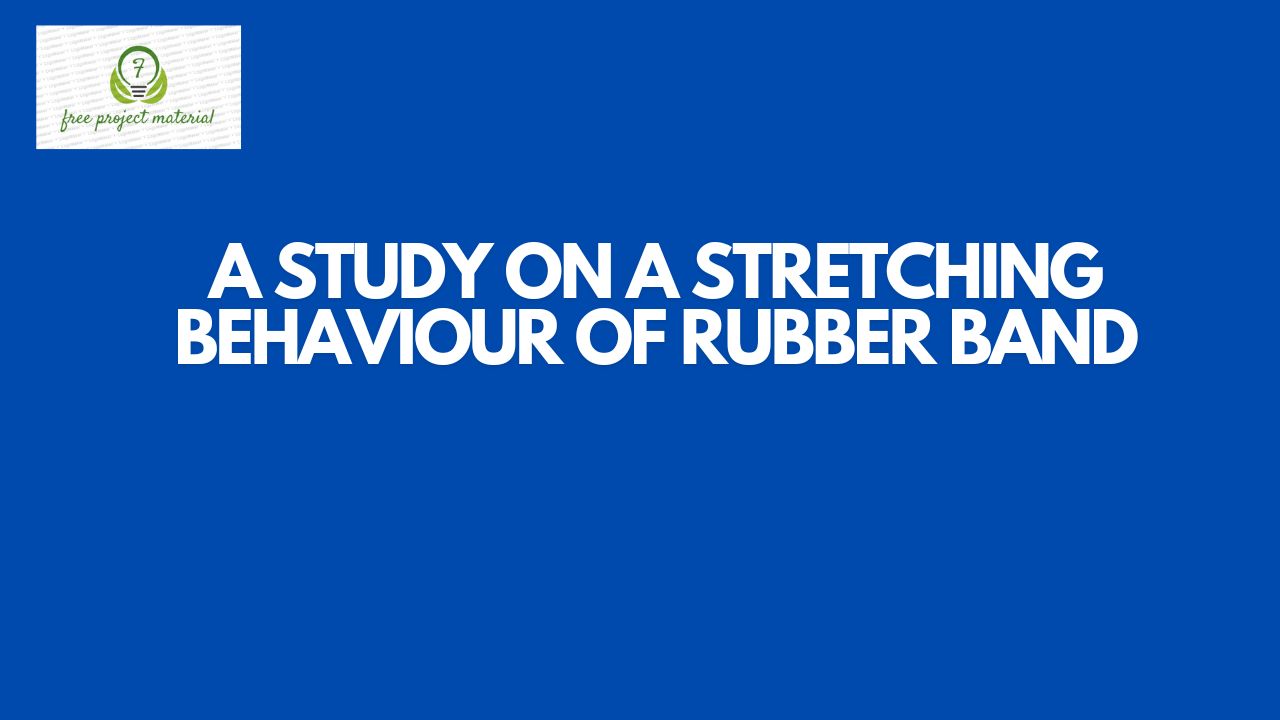ABSTRACT
This study on the stretching behaviour of rubber band was carried out using standard laboratory method, the study revealed that at (L = 0.16895m and e = 0.001845m), (L=0.1883m and e =3.0135m), (L=0.30m and e = 0.2198m), (L=0.3766m and e= 0.219m and (L=0.4375m and 0.2807m) the value of the Young’s modulus were 2.19N/m2, 1.454N/m2, 9.5N/m2, 20.06N/m2, and 12.827N/m2 respectively. This shows that at smaller length of the rubber band with small extension the rubber band showed a lower value of Young’s modulus but with increasing length and extension, the Young’s modulus of the rubber band equally increased. Further studies is recommended on different brand of rubber band in order to ascertain the one with the best elastic behaviour.
TABLE OF CONTENTS
Title Page – – – – – – – – – i
Certification – – – – – – – – – ii
Dedication – – – – – – – – – iii
Acknowledgement – – – – – – – iv
Abstract – – – – – – – – – v
Table of Content – – – – – – – – vi
CHAPTER ONE: INTRODUCTION
1.1 Background of the Study – – – – – – 1
1.2 Aim and Objectives of the Study – – – – 3
1.3 Scope of the study – – – – – – – 3
1.4 Definition of Terms – – – – – – 3
CHAPTER TWO: LITERATURE REVIEW
2.1 Molecular-level models – – – – – – 5
2.2 Thermodynamics – – – – – – – 5
2.3 Polymer Chain Theories – – – – – – 6
2.4 Various forms of Potential Energy – – – – 7
2.4.1 Chemical Potential Energy – – – – – 7
2.4.2 Elastic Potential Energy – – – – – – 7
2.4.3 Electrical (Electromagnetic) potential Energy – – 8
2.4.4 Gravitational Potential Energy – – – – – 9
2.4.5 Nuclear Potential Energy – – – – – – 10
2.4.6 Thermal Energy – – – – – – – 11
2.5 How Temperature Affects the Stretch of a Rubber Band – 11
2.5.1 Molecules and motion – – – – – 11
2.5.2 Effects of Heat on a Rubber Band – – – – 12
2.5.3 Effects of Cold on a Rubber Band – – – – 12
CHAPTER THREE: MATERIALS AND METHODS
3.1 Materials and Equipment – – – – – 13
3.2 Methods – – – – – – – – 13
CHAPTER FOUR: RESULT AND DISCUSSION
4.1 Results – – – – – – – – 15
4.2 Determination of the Area of the Rubber Band – – 17
4.3 Determination of Force Applied to the Elastic Material – 18
4.4 Determination of Young’s Modulus – – – – 18
4.5 Discussion – – – – – – – – 23
4.6 Application of Rubber Band – – – – – 24
CHAPTER FIVE: CONCLUSION AND RECOMMENDATION
5.1 Summary – – – – – – – – 26
5.2 Conclusion – – – – – – – – 26
5.3 Recommendation – – – – – – – 27
References
CHAPTER ONE: INTRODUCTION
1.1 Background of the Study
Rubber band (also known as elastic band, gum band or lacky band) is a loop of rubber, usually ring or oval shaped and commonly used to hold multiple objects together. The rubber band was manifested in England on March 17, 1845 by Stephen Perry. Rubber band is a narrow band of elastic rubber used to hold things (such as papers) together. Many materials and substances can return to their original shape and size after being pulled on or twisted. This property is called elasticity.
Elastic substances respond to forces acting on them by showing a change in their dimension and return to their size when force is withdrawn from them. Stress is the force imposed on the unit area of the substances, and strain is the ratio of change in size to the original size. Hooke’s law states that strain is directly proportional to the stress subjected within a specific range on an elastic substance, and the constant for proportionality is called the elastic modulus. According to Hooke’s law, F = -k∆x, where: F is the spring force, K is the elastic modulus specific to the materials, and ∆x is the displacement (Hanson and Martin, 2010).
Rubber elasticity is a property of crosslinked rubber, it can be stretched by up to a factor of 10 from its original length and when released, return very nearly to its original length. This can be repeated many times with no apparent degradation to the rubber. Rubber elasticity is produced by several complex molecular. Rubber elasticity is produced by several complex molecular processes and its explanation requires a knowledge of advanced mathematics, chemistry and statistical physics, particularly the concept of entropy. Entropy may be thought of as a measure of the thermal energy that is stored in molecule. As a rubber band is stretched, some of the network chain are forced to become straight and this causes a decrease in their entropy. It is this decrease in entropy that gives rise to the elastic force in the network chains (Stephen, 2009).
A material with a higher Young’s modulus (stiffness) often has lower toughness (energy). Similarly, high modulus and high strength are not necessarily correlated. A material may be brittle (with high modulus) but breaks at a low failure strength and, hence, has a low toughness (Gorodstove and Lisovenko, 2019). Thus this study was aimed at studying the stretching behaviour of a rubber band.
1. 2 Aim and Objectives of the Study
The aim of this study is to demonstrate elasticity of materials and those made by human and measure changes in length with different forces.
Objectives
- To determine the force of different types of rubber band
- To examine the factors affecting the stretch of a rubber band.
Scope of the Study
This research work deals with the study on the stretching behaviour of rubber band.
1.3 Definition of Terms
Rubber Band: is a thin circle of very elastic rubber. A narrow band of elastic rubber used to hold things (such as paper) together.
Hooke’s Law: This states that, strain on the material is directly proportional to the stress applied on the material.
Motion: This is the phenomenon in which an object change its position with respect to time, these are displacement, distance, velocity, acceleration, speed and frame of reference to an observe and measuring the change in position of the body relative to that frame with change in time.
Energy: Is the capacity for doing work. It may exist in potential, thermal, electrical, chemical, kinetic nuclear or other various forms of energy.
Kinetic Energy: is the energy of a moving objects. Examples: a speeding automobile, a thrown football, a marathon runner or a rock falling from a cliff.
Elasticity: Is the property of a body which enables the body to regain original dimension when a deforming force acting on the body is removed.



